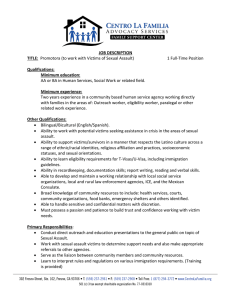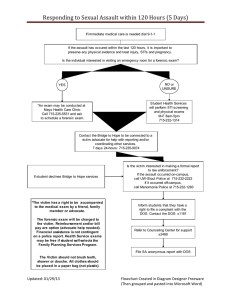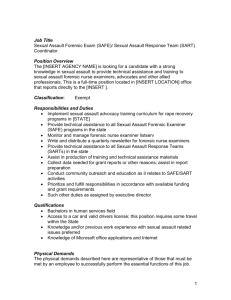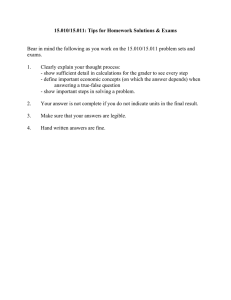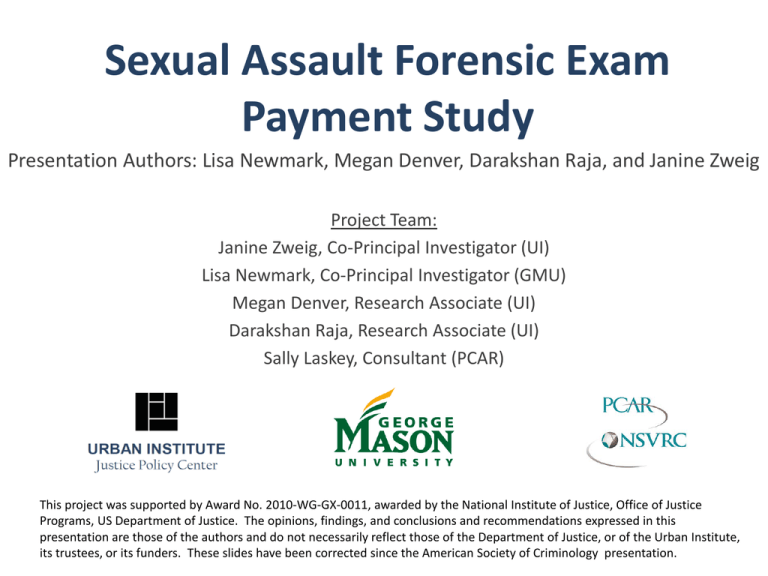
Sexual Assault Forensic Exam
Payment Study
Presentation Authors: Lisa Newmark, Megan Denver, Darakshan Raja, and Janine Zweig
Project Team:
Janine Zweig, Co-Principal Investigator (UI)
Lisa Newmark, Co-Principal Investigator (GMU)
Megan Denver, Research Associate (UI)
Darakshan Raja, Research Associate (UI)
Sally Laskey, Consultant (PCAR)
This project was supported by Award No. 2010-WG-GX-0011, awarded by the National Institute of Justice, Office of Justice
Programs, US Department of Justice. The opinions, findings, and conclusions and recommendations expressed in this
presentation are those of the authors and do not necessarily reflect those of the Department of Justice, or of the Urban Institute,
its trustees, or its funders. These slides have been corrected since the American Society of Criminology presentation.
The Criminal Justice System and
Victims of Sexual Assault
If the justice system is to accomplish its missions, it needs victims to
report crimes and provide evidence
For many reasons, victims of sexual assault are often reluctant to
report to law enforcement
-National surveys estimate reporting rates from 20% (Tjaden &
Thoennes, 2006) to 50% (Truman, 2011)
It’s critical to collect physical evidence of sexual assault quickly while
it’s still available
-The Sexual Assault Forensic Medical Exam collects forensic evidence,
provides medical services to victims, and can help link them to victim
services
Exams and Reporting Requirements
Prior to VAWA 2005, victims’ access to free forensic exams could be
conditioned on reporting to law enforcement
This practice presented victims with three difficult options:
-Make an immediate decision to report to law enforcement, or
-Assume financial responsibility for exams, or
-Lose the opportunity to collect valuable information for investigation
and prosecution, as well as receiving healthcare and victim services
VAWA 2005 Regulations
The Violence Against Women Act (VAWA) Reauthorization of 2005
required all jurisdictions to pay for sexual assault forensic exams,
regardless of whether victims cooperated with law enforcement
investigations, by January, 2009
-Based on the theory that more victims will undergo the exam if
they’re not pressured on the reporting decision, and will be more
likely to file an official report after the exam if they’ve had time to
think it over
States that are not compliant risk losing grant funding through the
STOP Violence Against Women Formula Grant Program.
No evaluation has been performed on implementation practices
related to the VAWA 2005 regulations since the 2009 deadline.
Subsequent Changes in State Legislation
Based on preliminary findings from a review of state/district/territorial
statutory and administrative codes:
– Provisions for free exams:
• 36 jurisdictions have explicit prohibitions against charging
victims for exams
• 3 jurisdictions provide for free exams but with certain conditions
or restrictions (other than law enforcement reporting)
• 14 jurisdictions don’t have explicit language in their statutory or
administrative codes that provides for free exams
Prohibitions against law enforcement reporting requirements for free
exams:
• 25 jurisdictions explicitly prohibit reporting requirements
• One jurisdiction has language that indicates victims must report
• 27 jurisdictions don’t have explicit language in their codes
Study of Payment Policies and Practices
Funded by the National Institute of Justice
Partnership between the Urban Institute, George Mason University, and
the National Sexual Violence Resource Center of the Pennsylvania
Coalition Against Rape
Four national surveys and case studies of 5 states and 3 localities within
each state
-National surveys of state-level agencies (STOP administrators, victim
compensation administrators, and state sexual assault coalitions) and
local community-based victim service providers
-Case studies will include victim focus groups and interviews with
healthcare-based exam providers, advocates, law enforcement, and
prosecution
Purpose of Study
Understand how sexual assault forensic exams are paid for throughout
the country;
Identify best practices to ensure that victims are never required to pay
for the forensic exam or to report the sexual assault to the police
before receiving a free forensic exam;
Examine the obstacles related to policy and practice and identify ways
to overcome them; and
Provide helpful information to states and localities across the nation.
Research Questions
To what extent are victims of sexual assault being charged,
either directly or indirectly, for the cost of exams?
What agencies are responsible for paying for forensic exams?
What are the payment practices? For example, do victims pay
up-front and get reimbursed, or never have to pay out-ofpocket?
Does the extent to which victims are willing to cooperate with
law enforcement affect whether or not they receive free
forensic exams or how the exam process is conducted?
Are “Jane Doe” rape kits or anonymous reporting procedures
used to encourage victims who have not yet made a police
report to undergo a sexual assault forensic exam?
Research Questions, cont.
Is medical care becoming more accessible to sexual assault
victims?
Are counseling and advocacy referrals part of the exam
process?
Do non-English speakers encounter greater obstacles to
receiving sexual assault forensic exams than English speakers?
What challenges to adherence with regulations exist?
What works well when addressing regulations?
Potential Implications
Findings from this study will:
– Increase knowledge in the field about how VAWA 2005
regulations are implemented
– Identify challenges to implementation
– Identify innovation and what works well when it comes to
implementation
– Improve the field’s understanding of how regulations
affect victims who participate in sexual assault forensic
exams, including victim participation in the criminal justice
process, satisfaction and safety
– Identify potential strategies for improving implementation
procedures and better serving the needs of victims
Preliminary Survey Findings
State-level survey response rates to date:
State STOP
Administrators
(SSA)
State Crime
Victim
Compensation
Administrators
State Sexual
Assault
Coalitions
Respondents/
total number
52/56
41/53
47/58
Response rate
93%
77%
81%
Approximately 400 community-based sexual
assault victim service providers have
completed a survey as well
Preliminary Survey Findings (SSA)
• Which funding sources pay for sexual assault
forensic exams?
Most commonly reported
sources
#1
Victim compensation funds
(62%, n=32)
#2
Victim’s insurance or public benefits
(23%, n=12)
#3
Other state funds (which may include STOP
funds) and other local funds
(each at 19%, n=10)
For respondents reporting Victim
Compensation as a funding source in
their state, 69% of SSAs reported this
was the top paying source for the state.
Use of Victim Compensation Funds
Victim Compensation
– Median amount spent on forensic exam claims in
2010: $823,692
– Median amount spent on all claims in 2010:
$6,038,560
– Median percent of forensic exam claims: 14%
Average amount spent per claim
varies widely by state (from
$385 to $1125). The median for
the sample is $621.
Use of STOP Funds
STOP funds provided to states (2010):
$1,720,876 (median)
$112,594 – $13,000,000 (range)
Of the 5 State STOP Administrators who reported
using STOP funds to pay for forensic exams, 2
reported amounts paid for these exams:
– State 1: $560,600 (of $797,160 total funds 70%)
– State 2: $785 (of $1,459,572 total funds .05%)
Preliminary Survey Findings
Challenges surrounding implementation
Coalitions
#1
Law enforcement resists change
(38%, n=18)
#2
Payment levels are too low
(30%, n=14)
Prosecution resists changes
(23%, n=11)
#3
Paying agencies lack funds for free
exams (23%, n=11)
State agencies have difficulty providing
training
(23%, n=11)
SSA
Payment levels are too low
(17%, n=9)
State agencies have difficulty providing training
(17%, n=9)
Paying agencies lack funds for free exams (13%,
n=7)
Law enforcement doesn't work well with victims
(12%, n=6)
Law enforcement doesn't work well with SA
agencies (12%, n=6)
I’m not sure (12%, n=6)
Preliminary Conclusions
Who pays?
Preliminary findings indicate Victim Compensation
funds are a top funding source
Is the payment process working?
85% (n= 40) of coalitions and 56% of SSAs (n=29)
reported at least one challenge
Common challenges in implementing VAWA 2005:
payment levels are too low for services provided,
paying agencies lack the funds to provide free exams
to all victims who choose to have them, and state
agencies have difficulty providing training
Stayed tuned for more . . .
Data collection on national surveys will be
finished by the end of the year
Case study site visits are scheduled for spring
and summer 2012
Final reports and ASC presentation expected
fall 2012
References
• Tjaden, Patricia and Nancy Thoennes (2006). Extent, Nature, and
Consequences of Rape Victimization: Findings From the National Violence
Against Women Survey. National Institute of Justice Special Report. NCJ
210346.
• Truman, Jennifer (2011). National Crime Victimization Survey: Criminal
Victimization, 2010. Bureau of Justice Statistics Bulletin. NCJ 235508.

